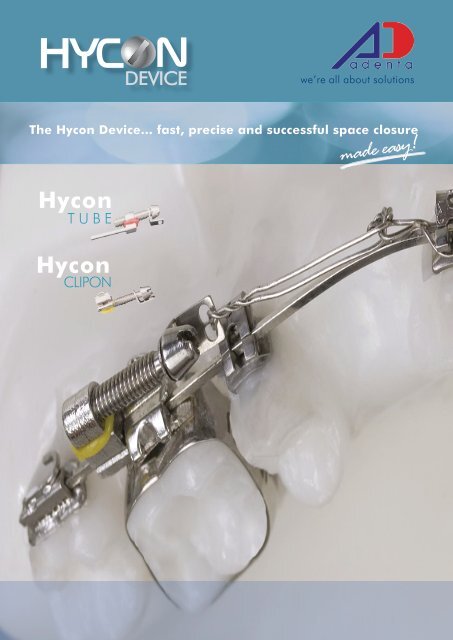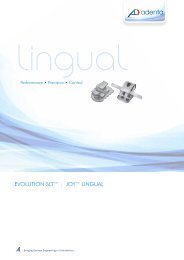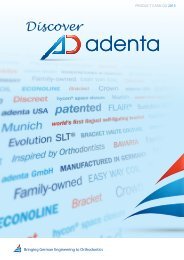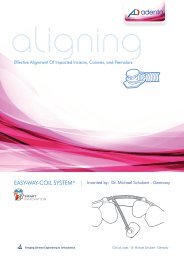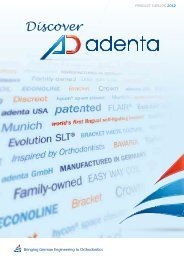Hycon - Adenta
Hycon - Adenta
Hycon - Adenta
You also want an ePaper? Increase the reach of your titles
YUMPU automatically turns print PDFs into web optimized ePapers that Google loves.
H y c o n D e v i c e ®f o r s p a c e c l o s u r e“Closing spaces with a different mechanical principle”Dr. Schütz“ When I started working as an orthodontist, I was not sure of the force generatedby my closing loops. I was concerned about the periodontium tissue. The idea toclose the space by means of screw mechanics eased my mind. Since 1984 all myspace closing has been done by the <strong>Hycon</strong> - it has never failed me. Sometimesmy colleagues tell me, that they are able to treat cases with the <strong>Hycon</strong> device,that before would have been beyond therapy. This is especially important for theperiodontal compromised adult patients.“the hycon device.... fast, precise and<strong>Adenta</strong> has worked closely with Dr. Winfried Schütz ofGermany to engineer a unique device to provide a technicalapproach for a step by step tooth movement: mesially,distally, but more specifically for space closure. With eachactivation, the <strong>Hycon</strong> ® Device enables to move the tooth ina precise and controlled motion, insuring permanent bloodsupply to the surrounding periodontal structures. This devicepermits exact and controlled activation in small steps. Witheach 360 degree turn the <strong>Hycon</strong> screw moves by .014” /0.35mm - precisely.<strong>Hycon</strong> ClipOn - self-ligating lockingclip in closed state.The ADenta Companies: Germany - phone: +49-8105-73436-0 email: info@adenta.com website: www.adenta.com page 2
H y c o n ®D e v i c e sHYCON ® TUBE HYCON ® CLIPONHolding pin of the <strong>Hycon</strong> Tube to beinserted into auxiliary tube.Archwire indicatedSelf-ligating lockingclip openThe <strong>Hycon</strong> ClipOn requires no auxiliarytube, simply clip onto archwire.successful space closureThe Alphabet of HYCON ® Features• Activated in small defined rates - .014” per turn.• Brings about pain free function.• Compatible with all straight arch systems• Demands only minimum of tissue turnover.• Enables the application of intermitting forces.• Facilitates disassociation of activation length and generated force.• Gives the opportunity for additional tissue regeneration.• Helps reduce chair-time - as activated by the patient.• Improves and simplifies treatment.• Makes tooth movement predictable.• Operates with screw power.• Overcomes any friction of the arch wire.• Permits easy and precise control of anchorage.• Provides almost ideal bodily tooth movement.• Speeds up space closure.• Warrants permanent blood circulation for theinvolved periodontium.made easy!The ADenta Companies: USA - phone: 215-942-2070 Toll Free: 1-888-942-2070 email: info@adentausa.com website: www.adentausa.com page 3
H y c o n ®D e v i c e sPhysiologic ReferenceThe <strong>Hycon</strong> minimizes tissue turnover.The force exerted by turning the screw is entirely sufficientto overcome friction, without requiring an activationgreater than the periodontal space. This permitsadequate stimulation of tissue response, ensuringpermanent blood supply to the periodontium and thesurrounding structures. An ideal situation for optimalmetabolism, consequently osteoclast and osteoblastactivity is given.As friction is of little concern, the HYCON ® facilitatesutilization of arch dimensions that fully fit bracketslots and provide torque control. Deflection can bepractically neglected because the activation is of sucha short distance. These are important bio-mechanicalaspects because they allow a close approach to idealbodily tooth movement. As a result, tissue turnover isminimized providing a high efficiency of tooth movementwhile being stress free on the periodontium.An interesting investigation idea from India:Alkaline phosphatase as an indicator substanceThe alkaline phosphatase (bone specific also known as bones alkaline phosphatase (BAP)) is an enzyme that is activein the alkaline milieu. It is generated as a by-product of bone synthesis, produced by the osteoblasts and additionallyserves as a marker for bone regeneration processes. From this Prof. Dr. Anmol Khala concluded, that out of the quantityof measured alkaline phosphatase the activity of the bone metabolism and consequently the rate of bone turnover canbe determined.250%GRAPH 2: Increase of alkaline phosphatase level during tooth movement within 21 days.ALKALINE PHOSPHATASE LEVEL ( PERCENTAGES )225%200%175%150%125%100%BASE LINE 7 DAYS 14 DAYS 21 DAYSSliding mechanic<strong>Hycon</strong> DeviceAlkaline phosphatase level of unmoved teeth (Base Line)Data reported by Dr. A. Khala 2005.His experiment consisted of measuring the concentration of alkaline phosphatase in the gingival crevicular fluid of theshifted tooth. Here, the teeth - divided into two groups – were moved by different mechanisms. Group 1 was drifted bysliding mechanics, while with group 2 the <strong>Hycon</strong> was put into action.After a 3 week treatment period, there was a significant difference in the amount of alkaline phosphatase. Based on thephosphatase level of unmoved teeth, set at 100 percent, a considerable increase could be discovered in both groups.While in group 1 there was an increase of 65 percent, in group 2 (the <strong>Hycon</strong> group) the measured level of increase wasfound to be approximately 140 percent. This indicates that group 2 had the highest metabolic activity.Consequently, the largest rate of bone turnover and hence quickest tooth movement took place here.The ADenta Companies: Germany - phone: +49-8105-73436-0 email: info@adenta.com website: www.adenta.com page 4
H y c o n ®D e v i c e sThis 22.8 year old male presented with a Class I dental andskeletal pattern. He showed a satisfactory profile and hadpreviously been treated orthodontally with extraction of his lowersecond bicuspids. His upper lateral incisors were congenitallymissing, however, upper space closure had not been completedduring past orthodontic treatment. These spaces were closedduring treatment with the <strong>Hycon</strong>.Characteristics - ConceptsTotal control on activation.The force necessary to move a tooth must overcomethe friction between arch-wire and bracket, and alsomust stimulate tissue response.With elastic forces the amount of stretching or deflectionis proportional to the total force required. Therefore,in order to achieve the appropriate amount offorce, the activation length of an elastic mechanismhas to be far greater than the periodontal gap.In contrast to this the threaded screw-type mechanismallows the separation of force and distance. Themovement of the tooth is determined solely by theadvancement rate of the thread, and the amount ofactivation turns.Being independent of elastic forces it is thus possibleto exert a very precise activation at a fairly high forcelevel, but at a very short distance.A New Space Closure PrincipleScrew mechanics versus elastic forces.The HYCON ® is, activated in small steps at intervalswhich can be determined according to the conditionof the periodontal tissue. So by creating intermittenttooth movement, the <strong>Hycon</strong> allows recovery of thetissue in between activation steps.In contrast to the characteristics of elastic elements offorce, were the power being generated is proportionalto the activation stretch - a screw driven mechanismenables the separation of activation distance andforce. The screw’s force only plays a role insofaras being adequate enough to overcome frictionalforces.After the adjustment of the HYCON ® screw the applianceis once again passive. There are no existingelastic forces, what remains from the activation is aslight increase in “tissue pressure”. This is the physiologicalstimulus for the desired alteration processes.The ADenta Companies: USA - phone: 215-942-2070 Toll Free: 1-888-942-2070 email: info@adentausa.com website: www.adentausa.com page 5
H y c o n D e v i c e ®f o r s p a c e c l o s u r edifferent attachment options2are now available.HYCON ®TUBEHolding pin of the <strong>Hycon</strong> Tube to beinserted into auxiliary tube.Designed specfically with a support-wire which is inserted into the auxiliary-tube of themolar band from the mesial side and bent back.A double buccal tube is required for the use of this appliance.Available in .018” slot technique with a .018x.025 support wire.Available in .022” slot technique with a .021x.025 support wire.The ADenta Companies: Germany - phone: +49-8105-73436-0 email: info@adenta.com website: www.adenta.com page 6
H y c o n D e v i c e ®f o r s p a c e c l o s u r ehyconHYCON ®t ® u b e placement informationTUBE placement information01The HYCON ® TUBEblock. The teeth of the front block should be laced with afigure 8 ligature wire. In addition, (elastic) ligatures shouldbe used to hold the archwire to the front block teeth.03 Preparing the HYCON ® TUBEFig. 1: View of the HYCON ® TUBEThe HYCON ® TUBE consists of a bolt and nut combinationin which the nut is mounted on a support wire. A frictionbrake is installed to prevent the bolt from uncontrolledturning.Rate of advancement per turn .014” (Fig. 1)The HYCON ® TUBE is available with two support wire dimensions:for .018” slot technique a .018” x .025” supportwire and for .022” slot technique a .021” x .025” supportwire.Please note that on some .022” molar attachments thedimension of the auxiliary tube may be .018” x .025”.The tension wire (minimum .012” ligature wire) is bent into a “U”shape (Fig. 2a), inserted from the outer side into the two holesof the wire linking attachment (Fig. 2b), then pulled through andbent sharply in the direction of the tension. (Fig. 2c)Fig. 2a Fig. 2b Fig. 2cFig. 2a-c: application of the tension wire on the HYCONSCharacteristics and ConceptThe threaded (screw type) mechanism permits exact activationin small steps at intervals. Thus it allows to applyintermitting forces. The device’s high potential force rulesout friction as a factor, thus permitting the use of a strongstraight arch wire (Recommended arch wire dimension:.021” x .025” with .022” slot technique.)Consequently the tooth movement very closely approachesthe bodily type providing maximum torque control.02 Preconditions for the HYCON ® TUBE• Straight arch technique, i.e. no bends that could preventthe arch from sliding into the molar tube.• Straight wire appliance with auxiliary tube on themolar bands.• Leveling and aligning must be completed with a heavy,straight, rectangular steel wire installed. The teeth shouldbe grouped into blocks, normally two lateral and onefront, with the defined spaces each distally from the front04 Inserting the HYCON ® TUBEThe support wire is inserted into the auxiliary tube on themolar band from the mesial side, so that the nut points tothe buccal side. (Fig. 3)The HYCON ® is then fixed by bending the support wireback. Recommended instrument: Weingart type pliers orligature director.Fig. 3: insertion of the HYCON ® TUBE into the auxiliarytube of double buccal tube.The ADenta Companies: Germany - phone: +49-8105-73436-0 email: info@adenta.com website: www.adenta.com page 8
H y c o n ®t u b e05 Connecting the HYCON ® DEVICEThe tension wire connects the screw with the tooth orgroup of teeth on the other side of the space.Connecting Option 1: The tension wire is fastened to theeye of a Kobayashi ligature (Fig. 4). This can, if necessary,simultaneously be used to stabilize the front group of teethby means of a figure 8 ligature.5. Connecting the HYCON ® TUBEHYCON ® CLIPON06 Activation of the HYCON DEVICEUsing the small safety screwdriver which comes with theset (see page 10 for more details regarding the use of theSafety Screwdriver) , the patient usually activates the HY-CON ® about every three to four days by turning it clockwise.The HYCON ® has to be activated in 2 steps.First step: To reduce the slack of the connection wire thepatient should turn the screw clockwise until they feel aslight tension.Fig. 4: Connecting the tension wire by means of aKobayashi ligature.Connecting Option 2: Preferably in the case of individualtooth movement, e.g. in the event of distalisation of thecanine tooth, the tension wire can be ligated directly ontothe bracket or on the power hook.( Fig. 5)Fig. 5: Distalisation of a singel tooth (canine)Connecting Option 3: The tension wire may also be connecteddirectly to the arch, e.g. posted arch wires (Fig 6),Gurin Hook. In this respect, care is to be taken that thearch, in the course of activation, remains centered in themedial line. (Fig 7)Second step: The patient then has to turn the screw fora given amount, please refer to page 11 for details onactivation guidelines.A practical hint for the patient.When tighting the device with the safety screw driver, thepatient should simultaneously stabilize the tension wirewith a finger nail to prevent it from twisting.07 ReactivationIf there is still a space left after working the completerange of the screw, it is necessary to unscrew the deviceand to re-tighten the tension wire accordingly.Fig. 6: Ligature wire attached to power hook of posted arch08 Anchorage ControlAn inherent advantage of the method of space closureinvolving the HYCON ® is that there is less strain uponanchorage units. Activating the HYCON ® has an effecton both sides of the space. The additional use of meansof anchorage (intermax. elastics, headgear, palatal bar)enables the orthodontist to control anchorage, in orderto reduce or neutralize the effect of the HYCON ® on theside of the space where little or no tooth movement at allis required.Fig. 7: A drop of self-curing resin applied to the midlinemark is an easy way to prevent midline shift of the archwire.The ADenta Companies: USA - phone: 215-942-2070 Toll Free: 1-888-942-2070 email: info@adentausa.com website: www.adentausa.com page 9
H y c o n D e v i c e ®f o r s p a c e c l o s u r ehycon ® c l i p o n placement information01The HYCON ® CLIPONarchwire indicated03 Preparing the HYCON ® CLIPONThe tension wire (minimum .012” ligature wire), is bent into a “U”shape (Fig. 2a), inserted from the outer side into the two holes ofthe wire linking attachment (Fig. 2b), then pulled through and bentsharply in the direction of the tension. (Fig. 2c)Fig. 1: View of the HYCON ® CLIPON - clip in closedposition.The HYCON ® CLIPON is available for arch sizes.018” x .025” and .022” x .025”The following color marking of the elastics is to beobserved in the choice of each quadrant:a) Yellow: upper mandible right/lower mandible left.b) Black: upper mandible left/ lower mandible right.Characteristics and ConceptThe threaded (screw type) mechanism permits exact activationin small steps at intervals. Thus it allows to applyintermitting forces. The device’s high potential force rulesout friction as a factor, thus permitting the use of a strongstraight arch wire (Recommended arch wire dimension:.021” x .025” with .022” slot technique.)Fig. 2a Fig. 2b Fig. 2cFig. 2a-c: application of the tension wire on theHYCONS04 Inserting the HYCON ® CLIPONThe HYCON ® CLIPON is held using a Weingart plier suchthat the slot-shaped mouth shows horizontal to the plier jawsand towards the exterior. Note: Apply only enough pressureon the pliers to hold the HYCON ® CLIPON!Consequently the tooth movement very closely approachesthe bodily type providing maximum torque control.02 Preconditions for the HYCON ® CLIPON• Straight arch technique, i.e. no bends that could preventthe arch from sliding into the molar tube.• Leveling and aligning must be completed with a heavy,straight, rectangular steel wire installed. The teeth shouldbe grouped into blocks, normally two lateral and onefront, with the defined spaces each distally from the frontblock. The teeth of the front block should be laced with afigure 8 ligature wire. In addition, (elastic) ligatures shouldbe used to hold the archwire to the front block teeth.Fig. 3a Fig. 3b Fig. 3cHolding the HYCON ® CLIPON without pressure - clip inopen state (yellow arrow) Fig. 3a -3c magnified x 1.The slot of the HYCON ® CLIPON is pushed over the archwirefrom the buccal side until the slot is fully loaded. Onlynow increase pressure with the plier until the locking mechanismcloses and clicks into place.The ADenta Companies: Germany - phone: +49-8105-73436-0 email: info@adenta.com website: www.adenta.com page 12
H y c o n ®D e v i c e sFig. 4a Fig. 4b Fig. 4cFig. 4: a, archwire inserted and clip in open state.Fig. 4: b ,c Closing the HYCON ® CLIPON by applying pressurewith the pliers - clip in closed state (yellow arrow)05 Placing the HYCON ® CLIPON onto the arch1st Possiblity: Distally of the first molar, in the case that thefirst and second molars are banded and are connected by astrong steel arch.06Avoiding Occlusion Interference -HYCON ® CLIPONThe HYCON ® CLIPON is to be inserted in accordancewith the color code (see point 1). The HYCON ® CLIPONshould not cause any interference in the occlusion. Ingeneral: the thin wall of the clip slot always has to showtowards the occlusal side. In the case of minor occlusalinterference one can reduce the points of contact with asutitable bur on the occlusal side of the clip.07 Connecting the HYCON ® DEVICEThe tension wire connects the screw with the tooth orgroup of teeth on the other side of the space.Connecting Option 1: The tension wire is fastened to theeye of a Kobayashi ligature (Fig. 8). This can, if necessary,simultaneously be used to stabilize the front groupof teeth by means of a figure 8 ligature.5. Connecting the HYCON ® TUBEHYCON ® CLIPONFig. 5: Attaching the HYCON ® CLIPON onto the arch -distally from the first molar.2nd Possibility: In case the second molar is not banded,the HYCON ® CLIPON has to be placed mesially to thefirst molar and connected with a ligature to the molar attachment.Fig. 8: Connecting the tension wire by means of a Kobayashiligature.Connecting Option 2: Preferably in the case of individualtooth movement, e.g. in the event of distalisation ofthe canine tooth, the tension wire can be ligated directlyonto the bracket or on the power hook. Fig. 9Fig. 6: Attaching the HYCON ® CLIPON onto the arch, mesiallyto the first molar.never attach the HYCON ® CLIPON to afree standing end of the archCorrect positionIncorrect positionFig. 9: Distalisation of a singel tooth (canine)Connecting Option 3: The tension wire may also beconnected directly to the arch, e.g. posted arch wires(Fig. 10), or Gurin Hook. In this respect, care is to betaken that the arch, in the course of activation, remainscentered in the medial line. Fig 11.Fig. 7a correct positionFig. 7b incorrect positionFig. 7: a, b Correct and incorrect placement of theHYCON ® CLIPON on the arch.Fig. 10: Ligature wire attached to power hook of postedarchThe ADenta Companies: USA - phone: 215-942-2070 Toll Free: 1-888-942-2070 email: info@adentausa.com website: www.adentausa.com page 13
H y c o n ®c l i p o nFig. 11: A drop of self-curing resin applied to the midlinemark is an easy way to prevent midline shift of the archwire.08 Activation of the HYCON ®Using the small safety screwdriver which comes with theset, the patient usually activates the HYCON ® about everythree to four days by turning it clockwise.anchorage units. Activating the HYCON ®has an effecton both sides of the space. The additional use of meansof anchorage (intermax. elastics, headgear, palatal bar)enables the orthodontist to control anchorage, in orderto reduce or neutralize the effect of the HYCON ® on theside of the space where little or no tooth movement at allis required.11 Use of the Safety ScrewdriverIn order to prevent lateral slippage the HYCON ® safetyscrewdriver has a protective sheath around the blade.The HYCON ® has to be activated in 2 steps.First step: To reduce the slack of the connection wire thepatient should turn the screw clockwise until they feel aslight tension.Fig 13. Frontal view of the HYCON ® safety screwdriverIn order to activate the HYCON ® the safety screwdriverfirst has to be placed over the head of the screw.Fig 12. HYCON ® and safety screw driverSecond step: The patient then has to turn the screw forthe given amount. Please refer to page 15 for details onactivation guidelines.Fig 14. Placement of the HYCON ® safety screwdriverThe safety screwdriver is turned until its blade clicks intothe groove on the screw head of the HYCON ®A practical hint for the patient.When tightening the device with the safety screw driver,the patient should simultaneously stabilize the tensionwire with a finger nail to prevent it from twisting.09 ReactivationIf there is still a space left after working the completerange of the screw, it is necessary to unscrew the deviceand to re-tighten the tension wire accordingly.10 Anchorage ControlAn inherent advantage of the method of space closureinvolving the HYCON ® is that there is less strain uponFig 15. To lock into place turn the safety screwdriverclockwise.Finally the activation of the HYCON ®can take place.The direction of rotation is indicated by an arrow on thescrew driver grip.The ADenta Companies: Germany - phone: +49-8105-73436-0 email: info@adenta.com website: www.adenta.com page 14
CLINICAL CRITERIAH y c o n ®a c t i v a t i o n12Practical Hints - HYCON ® DEVICERetraction and Intrusion of the Maxillary Front BlockIn case a combined retraction and simultaneous gentleintrusion of the upper front teeth is desired, it is recommendedto bend an intrusion step right distally of thebrackets from the lateral incisors. One should start witha slight intrusion step in an .016 x .022 wire (.022 slotsystem) and increase archwire dimension and intrusionsteps subsequently. Thus, with an.019x.025 or 21x25intrusion archwire inserted one will reach the desiredclosure of the spaces simultaneously with a gentle workingintrusion.Space Closure and Midline CorrectionIn case of a dentoalveolar shift of the midline andresulting asymmetrical spaces, it is recommended tolace a front block with a figure 8 Kobayashi ligature,with the eye pointing to the wider space, that is, theside to which the midline should be corrected. First,the HYCON ® is applied to this one side only, until themidline shift is roughly corrected. Then, the HYCON ®is applied on the other side as well.Minor corrections in the mid-line can be completed byasymmetrical activation.Maximum AnchorageIn situations in which a maximum of anchorage isrequired (mostly in the upper jaw), it is recommendedto distalize the canines first. In this case the incisorsshould be laced with a figure 8 ligature wire (e. g.)while the connecting wire of the HYCON ® is ligatedto the canine only.In a second step, the incisor block can be retracted asexplained above.Stabilization after Space ClosureWith space closure completed as desired, it is recommendedto keep the result stable and passive for sometime, depending on the amount of completed toothmovement and the related adaptation of soft tissue.Activation by the patientWhen tightening the device with the screwdriver, thepatient should simultaneously stabilize the connectingwire with a fingernail to prevent it from twisting.HYCON ACTIVATION GUIDELINESANCHORAGE SITUATION OF CASE PRESENTED• RECIPROCAL SPACE CLOSURE• ANCHORAGE DEMAND: NONE( EQUAL BLOCKS ADJACENT TO SPACE )• RECIPROCAL SPACE CLOSURE• ANCHORAGE DEMAND: LITTLE *( DIFFERENT BLOCKS ADJACENT TO SPACE )• SPACE CLOSURE: ONE SIDE STATIONARY• ANCHORAGE DEMAND: MAXIMUM *( ANCHOR UNIT: WEAK )• ADOLESCENT PATIENT• OPTIMAL TISSUE RESPONSE• NO PERIODONTOSIS2 full turns per week[3 full turns per week]2 full turns per week 2 x 1/2 turn per week[3 x 1/2 turn per week]• VITAL ADULT PATIENT• NORMAL TISSUE RESPONSE• NO/LITTLE PERIODONTAL ISSUE2 full turns per week[3 x 1/2 turn per week]2 full turns per week[3 x 1/2 turn per week]2 x 1/2 turn per week[1 full turn per week]• ADULT PATIENT• REDUCED TISSUE RESPONSE **• REDUCED MARGINAL BONE RIDGE2 x 1/2 turn per week 2 x 1/2 turn per week 1 x 1/2 turn per week[2 x 1/2 turn per week]Important instruction to be given to the patient.Note: Gerneraly two step activation is required.Preactivation: To reduce the slack of the connection wire the patient should turn the screw clockwise until they feel a slight tension.Actual activation: Only turn the screw in accordance with the instructions given by the orthodontist. (According to the above directions)IMPORTANT - THE HYCON FUNCTIONS PAINLESSLYDisclaimer: Please be advised this activation guideline can not take the place of the orthodontist expertise and visual inspection.[ ] indicates an alternative possibility of activation - based on individual findings* additional measures of anchorage are necessary (intermaxillary elastics, HG) see back page** additional prolonged interval between activation should be given occasionally (due to tissue response)The ADenta Companies: USA - phone: 215-942-2070 Toll Free: 1-888-942-2070 email: info@adentausa.com website: www.adentausa.com page 15
we’re all about solutionsGerman OfficeGutenbergstraBe 9, 82205 Gilching, Germany. phone: +49-8105-73436-0email: info@adenta.com website: www.adentausa.comUSA Office81 Clover Road, Ivyland, PA 18974 phone: 215-942-2070email: info@adentausa.com website: www.adentausa.com


